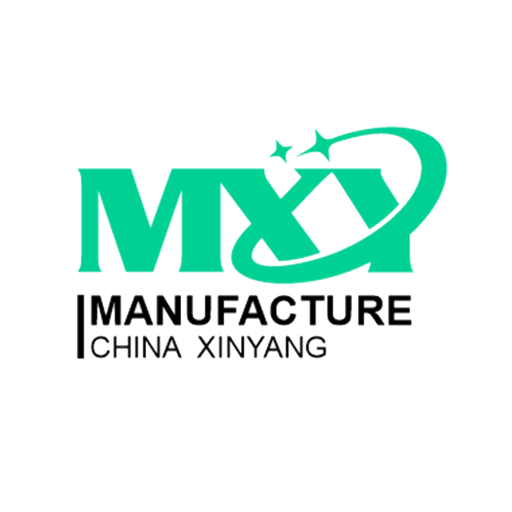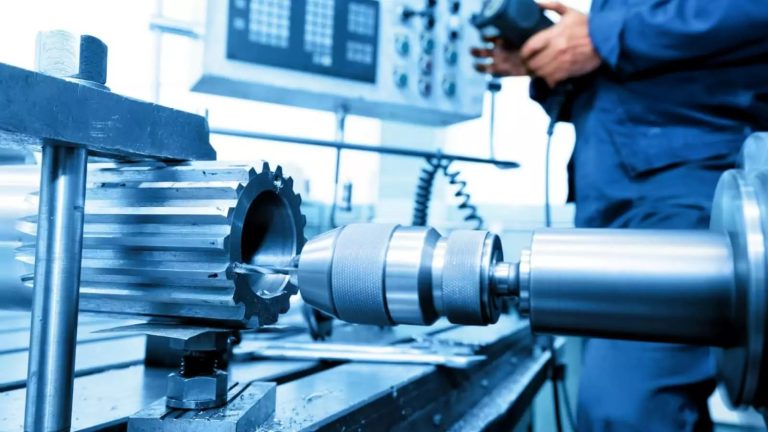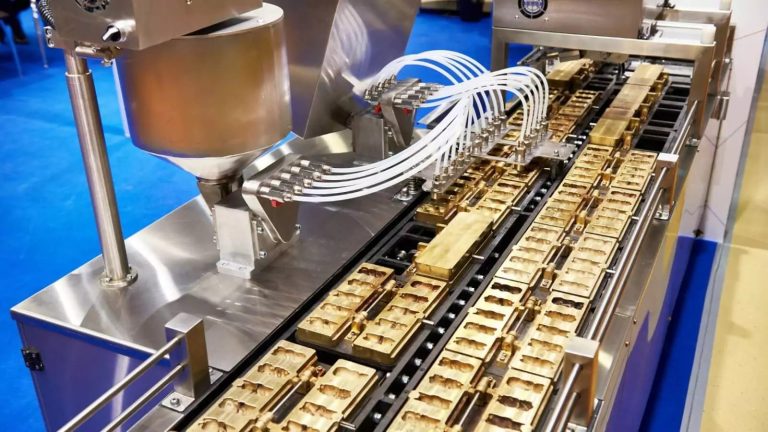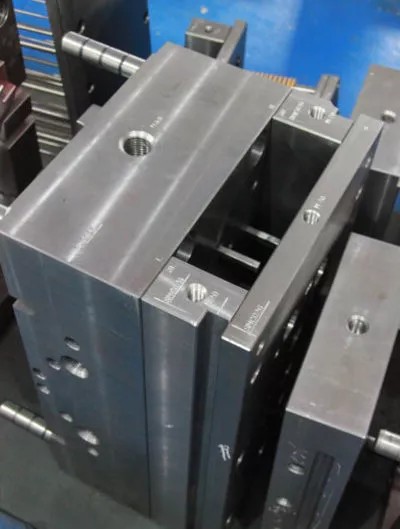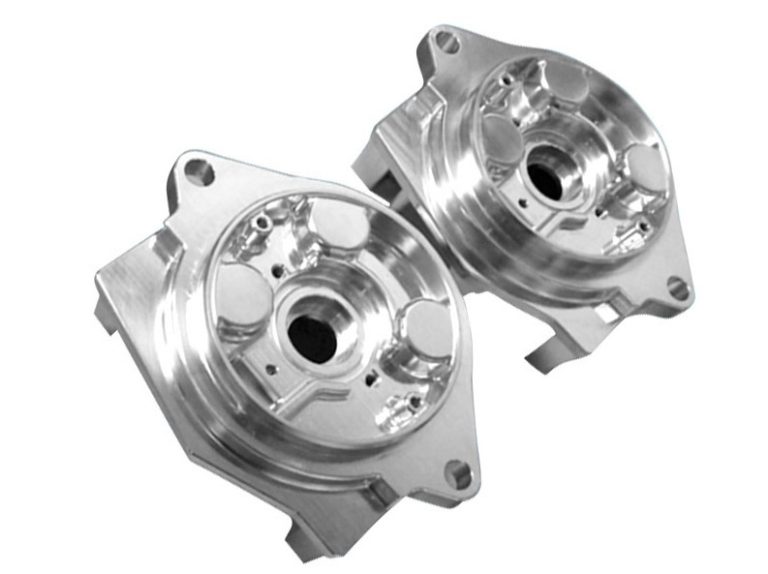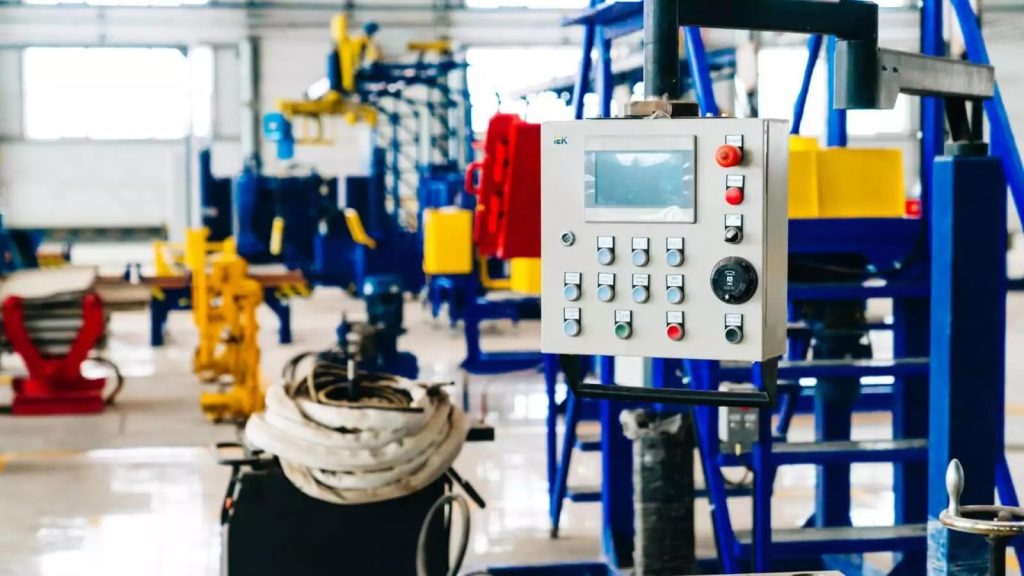
Electrical Discharge Machining (EDM) represents a fascinating fusion of electricity and precision engineering, revolutionizing how we approach manufacturing complex components.
This article aims to demystify EDM, a technique less familiar yet integral to modern manufacturing, by exploring its processes, applications, and evolution. From intricate aerospace components to delicate medical devices, EDM’s role is pivotal in shaping the objects that shape our world.
Table of Contents
What is Electrical Discharge Machining (EDM)?

Electrical Discharge Machining, colloquially known as EDM, is a nonconventional machining process type that employs controlled electrical sparks to precisely shape materials.
This innovative approach allows for machining of electrically conductive materials, regardless of their hardness, into intricate shapes and fine details that traditional machining methods struggle to achieve.
Short History of Electrical Discharge Machining
The origin story of Electrical Discharge Machining (EDM) is as electrifying as the process itself. Born from the quest to harness the power of electrical sparks, EDM’s journey began in the 1940s. The Soviet scientists, B.R. and N.I. Lazarenko, are credited with pioneering this method, initially developed to prevent tungsten electrical contacts from eroding.
Their discovery laid the foundation for what would become a cornerstone in modern manufacturing.
Over time, EDM evolved from a novel technique to a sophisticated and essential process, widely embraced in industries such as aerospace, medical device manufacturing, and tool and die making.
This remarkable progression wasn’t just about mastering electric sparks. It was a story of continuous innovation, where each advancement in EDM technology opened new doors.
From the development of wire EDM, offering precision cuts in complex shapes, to the refinement of sinker EDM for creating detailed cavities, EDM has steadily expanded its capabilities. Today, it stands as a testament to human ingenuity, turning the destructive force of electrical discharges into a tool of precise and intricate craftsmanship.
How Does EDM Work?
Understanding the EDM process is like peeling back the layers of a complex, electrical symphony. At its core, EDM is a non-conventional, thermal machining process that removes material from a workpiece by a series of rapidly recurring current discharges between two electrodes, separated by a dielectric liquid and subject to an electric voltage. One of the electrodes is the tool, while the other is the workpiece, both being electrically conductive.
When you delve deeper, EDM reveals its true character. The process starts with the tool and workpiece not touching each other. The space between them, known as the spark gap, plays a crucial role.
The power supply generates an electrical field in this gap, and when the voltage exceeds a certain threshold, a spark jumps across, melting and vaporizing the material on the surface of the workpiece. This fascinating dance of electricity doesn’t just randomly erode the workpiece.
The tool electrode’s shape and position are meticulously controlled to achieve the desired cut or form, making EDM a go-to for creating intricate designs and shapes in hardened steel and other metals.
The dielectric fluid, typically oil or deionized water, is more than just a bystander in this process. It serves multiple purposes – it cools the heated area, flushes away the eroded metal particles, and acts as an insulator until the spark occurs.
This controlled environment allows EDM to machine complex parts with high precision and excellent surface finish, a feat not easily achievable by conventional machining techniques.
What Are the Key Components of an EDM System?
Diving into the heart of Electrical Discharge Machining (EDM), one finds a sophisticated assembly of components, each playing a critical role in transforming electrical energy into precise machining capabilities. Let’s explore these components in detail:
Power Supply:
The power supply in an EDM system is the lifeline that drives the entire process. It’s not just about supplying electrical energy; it’s about precision. By regulating voltage, current, and frequency, the power supply ensures that the electrical discharges are just right – powerful enough to erode material from the workpiece yet controlled to maintain accuracy. Think of it as a maestro conducting an orchestra, where each spark is a note played in perfect harmony.
Control Unit:
At the core of an EDM machine lies its control unit, a marvel of modern computing. This system is where the complex choreography of the machine’s operations is orchestrated. It manages the intricate movement of machine parts and the precise timing of electrical discharges. Like a pilot navigating a plane through turbulent skies, the control unit ensures a smooth journey from start to finish, guaranteeing the precision of each cut and the integrity of the final product.
Dielectric System:
The dielectric system in EDM plays a multifaceted role. Comprising a reservoir filled with a dielectric fluid, usually oil or deionized water, this system is critical in the EDM process. It’s like a mediator that stands between the electrode and the workpiece. The fluid insulates them, preventing premature sparks. But once the conditions are right, it permits a controlled spark to pass through, eroding the workpiece. Additionally, it aids in cooling and flushing away the eroded material, ensuring a clean work environment and preventing overheating.
Work Tank:
Imagine the work tank as the stage where the EDM process unfolds. This container is designed to hold not just the workpiece but also the dielectric fluid. Its design is crucial as it needs to accommodate the dimensions of the workpiece and the electrode assembly. The work tank is where the raw materials enter and emerge as precisely machined components, thanks to the EDM process.
Electrode:
In electric discharge machining, the electrode is the protagonist that shapes the narrative. In sinker EDM, the electrode is a meticulously crafted tool made from conductive materials like graphite or copper, designed to create intricate shapes in the workpiece. In the world of wire EDM, the electrode takes the form of a thin, continuously moving wire, typically crafted from brass or coated copper. This wire acts like a precise scalpel, cutting through the workpiece to create detailed patterns and shapes.
Workpiece Holder and Fixture:
Stability and precision are paramount in EDM, and that’s where the workpiece holder and fixture come into play. These components securely hold the workpiece in place, ensuring that even during the most intricate machining processes, the workpiece remains stable. This is crucial for maintaining the precision and quality of the machining process, as even the slightest movement can lead to imperfections.
Servo Control System:
The servo control system in EDM is akin to a skilled craftsman, constantly adjusting the gap between the electrode and the workpiece. This system is essential for controlling the spark generation process, maintaining an optimal distance for efficient and precise material removal. It’s a delicate balance that requires precision and agility, much like a dancer maintaining perfect poise and balance.
Flushing System:
The flushing system in an EDM machine might seem like a supporting actor, but its role is crucial. It ensures a continuous flow of dielectric fluid to the gap between the electrode and the workpiece, serving two critical functions: removing eroded particles from the machining area and cooling the process. This not only enhances the efficiency of material removal but also preserves the integrity of both the electrode and the workpiece.
CNC (Computer Numerical Control) Interface (in automated EDM machines):
In automated EDM systems, the CNC interface represents the bridge between design and execution. This interface enables the precise programming of the machine, controlling the electrode movements with unparalleled accuracy. Often integrated with CAD/CAM systems, the CNC interface allows for the direct transfer of design specifications into machining instructions, ensuring that the final product matches the designer’s vision perfectly.
Filtration System for Dielectric Fluid:
The filtration system is the unsung hero in an EDM machine. It ensures that the dielectric fluid, which plays a critical role in the EDM process, remains clean and effective. By filtering out particles generated during machining, this system maintains the fluid’s efficiency, enabling it to be used repeatedly without losing its insulating and cooling properties.
Cooling System:
Last but not least, the cooling system in an EDM machine is essential for maintaining operational integrity.
What Are the Technological Parameters in EDM?
Electrical Discharge Machining (EDM), a marvel of modern manufacturing, operates on a symphony of technological parameters. Each parameter plays a pivotal role in ensuring the EDM process is both effective and efficient. Understanding these parameters is key to mastering EDM’s potential. Let’s delve into the critical parameters that govern the EDM process:
- Voltage: The voltage between the electrode and the workpiece is crucial. It determines when the electrical discharge occurs. Higher voltage can mean more aggressive machining, but it must be carefully balanced to avoid damaging the workpiece.
- Current: This parameter dictates the intensity of the electrical discharge. In simple terms, the higher the current, the larger the amount of material removed per spark. Managing this is essential for achieving desired surface finishes and machining speeds.
- Pulse Duration: Also known as “on-time”, this parameter refers to how long the spark occurs. Longer pulse durations lead to deeper craters and more material removal but can affect the surface finish and integrity.
- Duty Cycle: This represents the ratio of pulse duration to the total cycle time (including the off-time). It influences the cooling time and flushing efficiency, which are critical for maintaining workpiece integrity.
- Gap Voltage: This refers to the voltage across the spark gap before discharge. It’s essential for initiating the spark and must be precisely controlled for efficient machining.
- Dielectric Fluid Type and Pressure: The type of dielectric fluid used, and its pressure, greatly influence the EDM process. They affect the spark intensity, material removal rate, and the flushing away of eroded materials.
What are the Different Methods & Techniques used in Electrical Discharge Machining?

In the realm of EDM, a variety of methods and techniques have been developed, each tailored to specific needs and applications. These methods showcase the versatility of EDM in machining complex shapes and delicate features across various industries.
Sinker EDM (Die-Sink EDM):
Sinker EDM, also known as Ram EDM or Die-Sinking, is a method where both the electrode and the workpiece are submerged in a dielectric fluid. The electrode in Sinker EDM is custom-shaped, a mirror image of the desired cavity or shape to be created in the workpiece. It’s like a sculptor carefully chiseling away material to form a masterpiece.
This method is particularly advantageous for crafting complex geometries such as molds and dies, where intricate cavities and precise shapes are required.
The control over electrode movement and the use of various electrode materials, like graphite or copper, allow for a high degree of customization and precision. Sinker EDM is a go-to choice for applications demanding tight tolerances and intricate designs, such as in the aerospace and automotive industries.
The Sinker EDM process involves a series of electrical discharges between the electrode and the workpiece, with the dielectric fluid acting as a moderator. These discharges erode the workpiece, mirroring the shape of the electrode.
The process is characterized by its ability to achieve complex cavities and undercuts, which might be challenging or impossible to achieve with other machining methods.
The versatility of Sinker EDM makes it an invaluable tool in the manufacturing sector, offering solutions to some of the most challenging machining problems.
Wire EDM:
Wire EDM stands out for its precision and ability to create intricate and detailed cuts. In this method, a thin, electrically charged wire, typically made of brass or coated copper, acts as the cutting tool. The wire, continuously fed through the workpiece, follows a programmed path to slice through the material, even the hardest of metals like tungsten carbide, with high precision.
This technique is ideal for crafting intricate contours and delicate shapes, making it a perfect choice for manufacturing punches, tools, and dies.
The precision of Wire EDM allows for the creation of components with tight tolerances and intricate details, essential in industries like aerospace, where every micron counts. The method shines in its ability to cut complex shapes and sharp internal corners with a high-quality surface finish, showcasing its role as a precise, efficient, and versatile machining solution.
Fast Hole Drilling EDM:
Fast Hole Drilling EDM is a specialized technique designed for creating deep, accurate holes swiftly in any electrically conductive material. This method employs tubular electrodes, different from those used in conventional EDM, to blast holes with precision. It’s an invaluable tool in industries like aerospace, where it’s commonly used for creating cooling holes in turbine blades.
The precision and speed of Fast Hole Drilling EDM make it an indispensable tool for applications requiring high accuracy and efficiency.
Its ability to quickly produce holes with tight tolerances is crucial in sectors where time is of the essence, and precision is non-negotiable.
This method has revolutionized how industries approach tasks that once were time-consuming and labor-intensive, offering a faster, more accurate solution.
Multi-Axis EDM:
Multi-Axis EDM represents an evolution in the capabilities of traditional EDM. By incorporating additional axes of movement, this method allows for the machining of more complex geometries, suitable for intricate 3D shapes.
This added versatility opens up new possibilities in design and manufacturing, enabling the creation of components with complex curves and angles that would be challenging or impossible with traditional two-axis EDM.
Multi-Axis EDM is particularly suitable for applications where the component’s geometry goes beyond simple planes and requires detailed 3D shaping. Its ability to navigate and machine intricate paths makes it a valuable tool in advanced manufacturing sectors, including medical device production and specialized automotive components.
The precision and flexibility of Multi-Axis EDM have made it a go-to solution for tasks demanding a high level of intricacy and detail.
Micro EDM:
Micro EDM is a variation of the standard EDM process, fine-tuned for extremely small machining tasks. This method is a boon for industries where miniaturization is key, such as in medical device manufacturing, electronics, and micro-mechanical systems.
In micro-manufacturing, the precision and ability to work with a variety of materials make Micro EDM an indispensable tool.
The technique is perfect for producing minute components with high precision and intricate detail. It operates on the same principle as traditional EDM but on a much smaller scale, allowing for the machining of features down to micron levels. This precision is crucial in industries like medical technology, where components not only need to be small but also extremely accurate and reliable.
EDM Milling:
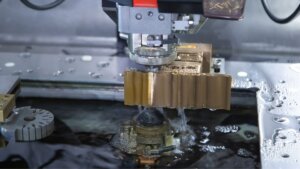
EDM Milling is an innovative adaptation of EDM, combining the principles of traditional milling with the unique capabilities of electrical discharge machining. This method utilizes an EDM head that moves in a traditional milling pattern, enabling it to machine intricate components with detailed features.
EDM Milling is particularly suitable for parts that require complex geometries and fine features that conventional milling can’t achieve.
It’s a game-changer for producing intricate molds, dies, and complex aerospace components. The ability to precisely control the EDM head allows for the creation of detailed and precise shapes, making it a favored choice in precision engineering fields.
Wire Thread EDM:
Wire Thread EDM is a specialized technique within the realm of Wire EDM. This method is particularly focused on threading the start hole required in Wire EDM processing. It’s an essential step that lays the groundwork for the entire wire-cutting process, especially when dealing with intricate and delicate wire paths.
This technique allows for precise initiation of the wire path in the workpiece, ensuring that the subsequent wire cutting is accurate and efficient. Wire Thread EDM is critical in situations where the wire must navigate through complex geometries or when starting the wire cut in a pre-machined hole is necessary.
Its precision and reliability make it an integral part of the Wire EDM process, especially in applications requiring high precision, such as in the manufacturing of intricate tools and components.
What Materials Can Be Machined by EDM?
Electrical Discharge Machining (EDM) is known for its versatility in handling a wide range of materials, especially those that are electrically conductive. Here’s a list of materials commonly machined using EDM:
- Steel: Including hardened and stainless steel varieties, known for their toughness.
- Aluminum: Lightweight yet strong, ideal for various applications.
- Copper: Known for its excellent electrical conductivity.
- Brass: A copper alloy that’s easy to machine.
- Titanium: Famed for its strength and corrosion resistance.
- Tungsten Carbide: Extremely hard and wear-resistant.
- Inconel: A nickel alloy, known for its ability to withstand extreme temperatures.
- Hastelloy: Another nickel alloy, known for its corrosion resistance.
- Graphite: Used for making EDM electrodes.
- Silver: Valued for its thermal and electrical conductivity.
- Gold: Often used in electrical connectors and other precision components.
- Kovar: An alloy designed to withstand varied thermal expansion rates.
What Are the Applications of EDM?
The applications of EDM span various industries, each benefiting from the precision and versatility of this machining process. Here are ten industries where EDM plays a pivotal role:
- Aerospace: For machining complex components like turbine blades and engine parts.
- Automotive: Used in creating molds and dies for car components.
- Medical Devices: For producing intricate implants and surgical tools.
- Electronics: In manufacturing semiconductor parts and connectors.
- Tool and Die Making: Essential for creating molds, dies, and stamps.
- Defense: For producing parts used in military equipment and vehicles.
- Energy Sector: In machining components for nuclear, wind, and other energy systems.
- Research and Development: For prototyping and creating experimental parts.
- Telecommunications: Used in fabricating connectors and infrastructure components.
- Manufacturing Machinery: In creating gears, threads, and other complex machinery parts.
What are the Advantages & Disadvantages of Electrical Discharge Machining?
Electrical Discharge Machining (EDM) is a highly specialized manufacturing process, offering a unique set of advantages and challenges. Understanding these can help you determine if EDM is the right solution for your machining needs.
Advantages of EDM:
- Ability to Machine Complex Shapes: EDM excels at creating intricate and complex shapes, especially internal cavities and sharp internal corners that are difficult to achieve with conventional machining methods.
- No Direct Contact: Since the cutting is done by electrical sparks, there’s no direct contact between the tool and the workpiece, minimizing mechanical stresses and tool wear.
- High Precision and Accuracy: EDM provides high precision machining, crucial for industries like aerospace and medical device manufacturing.
- Versatility with Hard Materials: It can easily machine hard materials like tungsten carbide, hardened steel, and titanium alloys, which might be challenging for other machining processes.
- Fine Surface Finish: Achieves excellent surface finishes, reducing or eliminating the need for additional surface treatment processes.
- Small Kerf Width: The wire used in Wire EDM can be very thin, allowing for fine cuts and minimizing material waste.
- No Burr Formation: The process doesn’t create burrs, reducing post-machining finishing work.
- Flexibility in Material Choices: EDM can work with a variety of electrically conductive materials.
Disadvantages of EDM:
- Material Limitations: Only electrically conductive materials can be machined, limiting its application range.
- Slower Production Rate: Compared to traditional machining methods, EDM can be slower, especially for thicker or harder materials.
- Higher Operational Costs: The cost of EDM, including equipment, maintenance, and electricity consumption, can be higher than conventional machining.
- Electrode Wear: In sinker EDM, the electrode wears over time, which can affect the accuracy of the machining process.
- Environmental Concerns: The use of dielectric fluids in EDM requires careful handling and disposal due to potential environmental hazards.
- Risk of Thermal Damage: The thermal process can potentially alter the material properties in the heat-affected zone.
- Complex Setup: Setting up EDM machines, especially for complex jobs, can be time-consuming and requires specialized knowledge.
- Limited Material Removal Rate: The rate at which material is removed can be slower than other machining processes, especially for large bulk material removal.
What Software is Used in EDM?
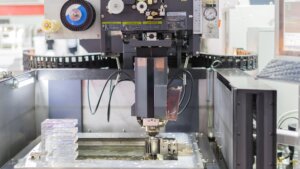
Electrical Discharge Machining (EDM) has evolved significantly with the integration of sophisticated software systems that enhance its precision and efficiency. These software tools are essential for EDM programming and control, and they often interface seamlessly with CAD/CAM systems, allowing for a streamlined transition from design to production.
- CAD/CAM Integration: Computer-Aided Design (CAD) and Computer-Aided Manufacturing (CAM) software are integral to modern EDM. These tools enable the precise design of parts and the generation of accurate machining paths. CAD/CAM software helps in converting complex designs into reality by guiding the EDM machine with detailed instructions.
- Simulation Software: Before actual machining, simulation software is used to visualize and optimize the EDM process. This helps in identifying potential errors or inefficiencies, thereby saving time and reducing material waste.
- CNC Interface Software: For automated EDM machines, CNC (Computer Numerical Control) software plays a pivotal role. It provides the interface for programming the machine’s operations, ensuring precise control of the electrode movements.
- Toolpath Generation Software: This software generates the specific paths that the EDM tool will follow, allowing for intricate designs and shapes to be machined with high accuracy.
- Process Monitoring and Control Software: Real-time monitoring and control software are used to oversee the EDM process. They adjust parameters like voltage, current, and pulse duration to optimize machining efficiency and quality.
These software systems collectively ensure that EDM remains a versatile, accurate, and efficient process suitable for modern manufacturing needs.
Is Electrical Discharge Machining expensive?
Evaluating the cost of Electrical Discharge Machining (EDM) involves considering various factors:
- Initial Investment: EDM machines, especially advanced models with extensive features, represent a significant initial investment. This cost can be higher compared to conventional machining equipment.
- Operational Costs: EDM requires specialized consumables like wire, electrodes, and dielectric fluid, which contribute to ongoing operational expenses. Additionally, electricity consumption in EDM is relatively high.
- Maintenance Costs: Regular maintenance is necessary to ensure precision and efficiency, adding to the operational cost.
- Labor Costs: Operating EDM machines requires skilled technicians, potentially leading to higher labor costs compared to less complex machinery.
- Material Utilization and Waste: EDM is known for its precision, which can lead to better material utilization and less waste, potentially offsetting some of the higher operational costs.
- Time Efficiency: Although EDM can be slower than some conventional methods, its ability to produce complex shapes in a single setup can result in overall time savings.
How is EDM Different From Other Machining Processes?
EDM stands out from other machining processes in several key aspects:
- Contactless Machining: Unlike traditional machining that relies on physical contact with the workpiece, EDM uses electrical discharges, eliminating mechanical stresses and tool wear.
- Material Hardness: EDM can easily machine extremely hard materials, which can pose challenges for conventional machining methods.
- Precision and Complexity: EDM excels in producing intricate shapes and fine details with high precision, which might be difficult or impossible with traditional machining.
- Surface Finish: EDM can achieve a superior surface finish, often eliminating the need for post-machining processes.
- Tool Wear: In EDM, tool wear is significantly less compared to traditional cutting tools, leading to better accuracy and less maintenance.
- Set-Up Time: Setting up EDM can be more time-consuming and complex, especially for intricate jobs, compared to some traditional machining processes.
- Material Restrictions: EDM is limited to electrically conductive materials, whereas traditional machining can handle a broader range of materials.
- Operational Cost: The operational cost of EDM can be higher due to factors like electricity consumption, specialized equipment, and maintenance.
Conclusion
In the landscape of modern manufacturing, Electrical Discharge Machining (EDM) stands out as a remarkably versatile and precise technique. Its unique ability to handle complex shapes and hard materials, coupled with high accuracy and fine surface finishes, makes EDM indispensable in various industries.
From aerospace to medical devices, EDM offers solutions where traditional machining methods reach their limits.
Despite its higher cost and specific material requirements, the precision and possibilities it unlocks in manufacturing are unparalleled, solidifying its role as a key player in advanced manufacturing processes.

